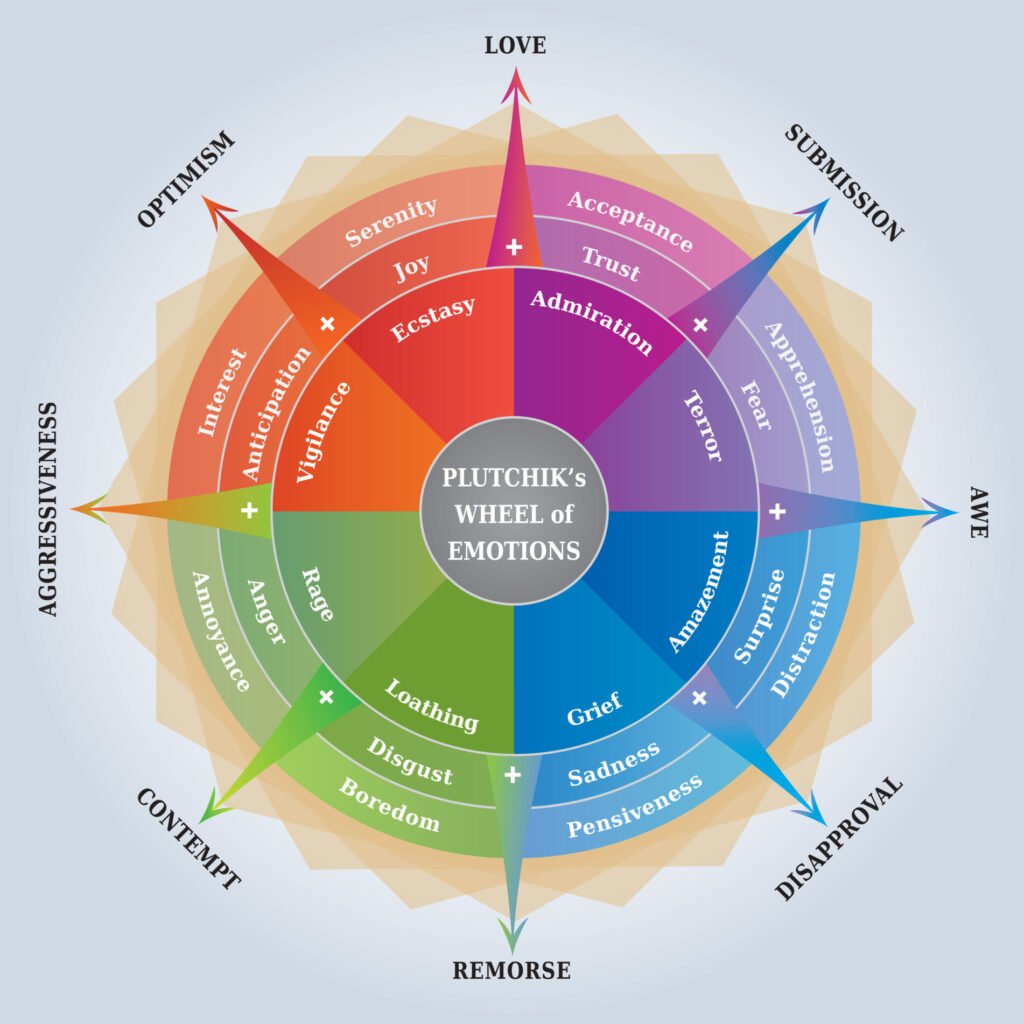On This Page:
Emotional intelligence (EI or EQ) is the ability to identify and regulate our own emotions as well as recognize, understand, and engage with the emotions of others (Goleman, 1996).
It is a critical skill to build stronger and empathetic relationships, and it helps connect with our deepest feelings, allowing us to make decisions that are more aligned with our values and personal goals.

Emotional intelligence is commonly defined by four attributes:
- Self-awareness is the ability to recognize our own emotions and the impact they have on others;
- Self-management is the capacity to regulate emotions, control impulsive reactions and flexibly adapt to changing circumstances;
- Social awareness is the ability to understand and empathize with the emotions of others;
- Relationship management comprises a set of social skills, including positive influence, teamwork, clear communication, and conflict management.
How to develop emotional intelligence
Emotional intelligence is a flexible skill that can be learned.
Even though some individuals might naturally be more emotionally intelligent than others, high EI can be developed with time through regular practice.
Below are some ways which may help to increase emotional intelligence.
Practice active listening
Active listening is about hearing beyond people’s words. It involves fully attuning to what is being communicated, including the content of the message and the attitude that underlies it (Rogers and Farson, 1957).
Paying attention to another’s body language, as well as the tone and speed of their voice, can help identify the speaker’s emotional state in that moment and any messages beyond what they are saying.
To practice active listening, it is important to let the other person’s train of thought flow without interruptions, as this will facilitate open communication and create a climate of trust and acceptance.
Secondly, controlling external and internal distractions can help facilitate active listening. In particular, the internal chatter in our minds and the need to plan our responses will allow us to be fully present in the moment and sharpen our listening skills (Lunenburg, 2010).
Emotional awareness
When experiencing uncomfortable emotions, we might have the tendency to ignore them or bottle them up rather than accept them as a normal and sometimes useful part of our life.
Leaning into our uncomfortable emotions can give us the opportunity to deal with our feelings productively, increasing our self-awareness and ability to introduce positive changes in our lives (Bradberry and Greaves, 2009).
By exploring with curiosity our full range of emotions, we can gain a more objective view of the person we are and how our feelings are influencing our actions. To see things from a wider perspective, we can also open up to feedback from others, asking about specific situations where we acted with poor emotional awareness.
Identify the emotions
Learning to label emotions with more specific vocabulary can help identify more precisely the type of emotional state we are experiencing and feel more in control of our responses (David, 2016).
Beyond the six core emotions – happiness, sadness, anger, fear, disgust, and surprise – there is a vast spectrum that can be explored through the emotions wheel (Figure 2).
By recognizing, for example, that sadness differs from boredom or a sense of loneliness; we can become better able to pinpoint our emotions and manage them effectively.
An additional strategy to develop emotional awareness might be keeping a diary, where we write a description of our emotions and how these are brought up by specific circumstances.
After a few weeks, we may begin to see patterns. We may come to understand which emotions are most difficult for us to tolerate, which ones are triggering, and which ones contribute to feeling more connected with our own values and satisfaction with our lives.

Understand your stressors
Knowing what situations are triggering is critical for developing the ability to manage our emotional reactions and maintain calm.
We can use a diary to also identify the sources of stress or write down a list that includes a) specific situations – when we are most likely to feel frightened, disempowered, or not in control b) people – for example, those who appear to be toxic, friends not respecting boundaries or work colleagues trying to impose their opinions c) conditions in the environment – such as crowded or noisy places.
This will help us anticipate our stressors and then think about ways to put in place strategies to handle our emotions more appropriately (Bradberry and Greaves, 2009).
Channel emotions in a healthy way
Once we develop greater openness towards our emotions, it is also important to learn how to use them to our advantage rather than letting them control us.
The first step is to avoid judging our emotions and labeling them as good or bad. Instead, we should recognize them as powerful sources of information which can be used to drive our actions toward what matters to us (Bradberry and Greaves, 2009).
Refocusing our attention on things that are under our control and can be improved also allows us to not feel trapped in a downward emotional spiral and engage in more committed actions.
To give our minds a break, we should also prioritize scheduling activities in our routines that make us feel mentally recharged. These may include exercise, yoga, meditation, or other relaxing activities for the mind.
How to encourage emotional intelligence in others
Developing emotional competencies is not only important at the personal level.
Encouraging emotional intelligence in others, including children, students, romantic partners, and work teams, can help increase sensitivity to emotional cues that are often missed within oneself and the environment and ultimately boost the quality of interpersonal relationships (Nagarjuna Nagar, 2020).
There are a few tips we can follow to enhance EI in others:
Be open and curious
Creating opportunities to share opinions can help build trust in both dyadic and group interactions, reinforcing the importance of self-expression and promoting transparent communication between individuals.
For example, in a work setting, we might start by asking our team how they are feeling about a particular decision rather than appointing a quick solution to a problem without explaining the rationale behind it.
We might also try to engage in conversations by asking our co-workers about things that disappoint them at work, what motivates them the most, and how they deal with emotional stress related to work.
Name the emotion
To encourage self-expression in others, such as in children, we might ask them to name an emotion matching their present state. If they find this exercise difficult or give flat answers like “I feel fine/good,” we can ask them to rate an emotion on a 1-10 scale or make use of the emotions wheel.
For example, you could ask: ‘How worried do you feel on a scale of 1-10?’
This technique can even work for adults who may struggle with identifying their emotions.
Offer your perspective
It may be useful to give some constructive feedback to others about situations where they acted with poor emotional awareness.
Did they not show enough care or support to people who needed their help? Did they say something that could be perceived as disrespectful or inconsiderate of others’ feelings? Are they often adopting unclear or inconsistent communication of tasks?
Ensure this feedback is not confrontational or using blaming language but expressed in a kind manner so as to encourage open, healthy discussion.
Promote a collaborative group culture
Encouraging cooperation within groups facilitates sharing of objectives, values, and concerns, which can ultimately result in an increased sense of group identity and commitment to tasks.
To enhance a team’s EI, we can highlight participants’ strengths and weaknesses, build a team spirit to spark passion and motivation and constantly provide a space to reflect on personal progress and ways to improve existing skills.
Why is emotional intelligence important?
“What really matters for success, character, happiness and life long achievements is a definite set of emotional skills – your EQ — not just purely cognitive abilities that are measured by conventional IQ tests.”
Daniel Goleman
In accordance with Goleman’s statement, emotional intelligence can benefit our personal and professional life in several ways.
It is a valuable tool to utilize when handling unpredictable and emotionally charged situations, it promotes better clarity of our motivations and goals, and it is an integral part of developing more satisfying relationships with others.
EI is also a significant predictor of professional success, believed to account for 58% of performance in all types of jobs (Bradberry and Greaves, 2006).
When is emotional intelligence important?
Overall, EI has been found to subsume a variety of skills that are critical in our day-to-day life (Figure 1).
Communication
Increased sensitivity to the feelings of others allows more effective communication and prevents the escalation of tension and conflicts.
As we are more aware of the emotional needs of the people we interact with, we are more likely to adopt a collaborative attitude and be open to compromise (Petrovici and Dobrescu, 2014).
Stress management
Recognizing how specific situations can trigger stressful emotions can help us feel more in control of our reactions, replacing negative feelings with appropriate coping skills to deal with them.
Neglecting how emotional stress drives our behaviors can lead to irrational decisions and ultimately exacerbate mental health outcomes (Ciarrochi, Deane, and Anderson, 2002).
Decision-making
Understanding how emotions influence our thoughts can prevent us from making misguided decisions, both in our personal lives and in the workplace.
As we are able to identify emotions that are superfluous or unrelated to a problem, we can form more objective judgments and enhance the quality of decision-making (Hess and Bacigalupo, 2011).
Change tolerance
Changes in our personal and professional life are constant and can sometimes be emotionally intense.
Reflecting on the emotional reactions that make us resistant to change as well as the interpretations and preconceptions associated with them, can help us assume a more positive outlook and think more optimistically about opportunities that can derive from change (Lin et al., 2016).
Motivation
With high EI, we can better understand the meaning of our aspirations and the motivational skills required to achieve goals in relation to our work, personal life, and health (Magnano, Craparo, and Paolillo, 2016).
In addition, with the capacity to recognize emotions, we can also impact other people’s motivations, encouraging positive attitudes towards shared goals when working in teams.
Frequently asked questions
Does emotional intelligence tend to improve with age?
Since EI is a skill that can be continuously developed and refined over time, it makes sense that our ability to deal with emotional challenges might increase with age.
Indeed, research suggests that older adults are better able to balance emotions and cognition when problem-solving and making decisions compared to their younger counterparts.
In addition, older adults seem to be better able to regulate emotions and minimize the intensity and duration of negative affect (Carstensen et al., 2000).
At the same time, it is important to acknowledge that a person’s age does not always mirror their level of emotional maturity, and some EI competencies might require more consistent practice and training (Fariselli, Ghini, and Freedman, 2008).
What problems can result from low emotional intelligence?
Low EI manifests with difficulty dealing with our own feelings and relating to the emotional experiences of others (Goleman, 1996).
Being emotionally disconnected may result in uncontrolled and impulsive behaviors, such as emotional outbursts, insensitive responses, or blaming others, all of which can compromise the quality of our relationships.
Ignoring other people’s feelings can also increase the risk of conflicts if the conversations are too closed, self-centered and foster misunderstandings (Hansen, 2015).
Ultimately, low EI may result in a reduction of a person’s social circle and level of emotional support, with detrimental effects on mental health and well-being.
Can you have a high IQ but low emotional intelligence?
Though IQ and EI are sometimes related, they represent two separate constructs that might present with different levels of development in the same person.
Having a strong ability to analyze and interpret situations (often associated with a high IQ) does not necessarily translate into the ability to read other people’s emotions or attend to emotional cues.
Similarly, the ability to find rational solutions to problems might not manifest in social situations where strong EI skills are needed to manage conflict and reach a compromise (Goleman, 2020).
Can emotional intelligence be taught to others?
Considering the increasingly important role of EI in academic and work success, as well as in managing stress and life transitions, there is a growing interest in teaching emotional intelligence to teenagers and students.
In a classroom environment, incorporating training focused on enhancing assertive communication and managing negative self-talk can result in an improvement in EI skills (Chang, 2006).
In addition, students who show the greatest benefit from EI programs are also more likely to persist with their studies in the future (Qualter et al., 2009).
In practice, introducing behaviors in classrooms that are informed by EI principles, such as promoting collaboration between students and practicing self-reflection exercises, can help students gradually assimilate this skill.
Sources
Atkins, P., & Stough, C. (2005). Does emotional intelligence change with age. In Society for Research in Adult Development annual conference, Atlanta, GA.
Bradberry, T., & Greaves, J. (2006). The emotional intelligence quick book: Everything you need to know to put your EQ to work. Simon and Schuster.
Bradberry, T., & Greaves, J. (2009). Emotional Intelligence 2.0. TalentSmart.
Carstensen, L. L., Pasupathi, M., Mayr, U., & Nesselroade, J. R. (2000). Emotional experience in everyday life across the adult life span. Journal of personality and social psychology, 79(4), 644.
Chang, K. B. (2006). Can we teach emotional intelligence?.
Ciarrochi, J., Deane, F. P., & Anderson, S. (2002). Emotional intelligence moderates the relationship between stress and mental health. Personality and individual differences, 32(2), 197-209.
David, S. (2016). Emotional agility: Get unstuck, embrace change, and thrive in work and life. Penguin.
Fariselli, L., Ghini, M., & Freedman, J. (2008). Age and emotional intelligence. Six Seconds: The Emotional Intelligence Network, 1-10.
Goleman, D. (1996). Emotional intelligence: Why it can matter more than IQ. Bloomsbury Publishing.
Goleman, D. (2020). Emotional intelligence. Bloomsbury Publishing.
Hansen, S. (2015). “10 Things High EQ People Don’t Do.” Lifehack. Web.
Hess, J. D., & Bacigalupo, A. C. (2011). Enhancing decisions and decision‐making processes through the application of emotional intelligence skills. Management decision.
Lin, D. T., Liebert, C. A., Tran, J., Lau, J. N., & Salles, A. (2016). Emotional intelligence as a predictor of resident well-being. Journal of the American College of Surgeons, 223(2), 352-358.
Lunenburg, F. C. (2010). Communication: The process, barriers, and improving effectiveness. Schooling, 1(1), 1-10.
Magnano, P., Craparo, G., & Paolillo, A. (2016). Resilience and Emotional Intelligence: which role in achievement motivation. International Journal of Psychological Research, 9(1), 9-20.
Nagarjuna Nagar, A. P. (2020). Can Emotional Intelligence Be Developed?. Editorial Board, 9(7).
Petrovici, A., & Dobrescu, T. (2014). The role of emotional intelligence in building interpersonal communication skills. Procedia-Social and Behavioral Sciences, 116, 1405-1410.
Qualter, P., Whiteley, H., Morley, A., & Dudiak, H. (2009). The role of emotional intelligence in the decision to persist with academic studies in HE. Research in Post‐Compulsory Education, 14(3), 219-231.
Rogers, C. R., & Farson, R. E. (1957). Active listening (p. 84). Chicago, IL: Industrial Relations Center of the University of Chicago.


